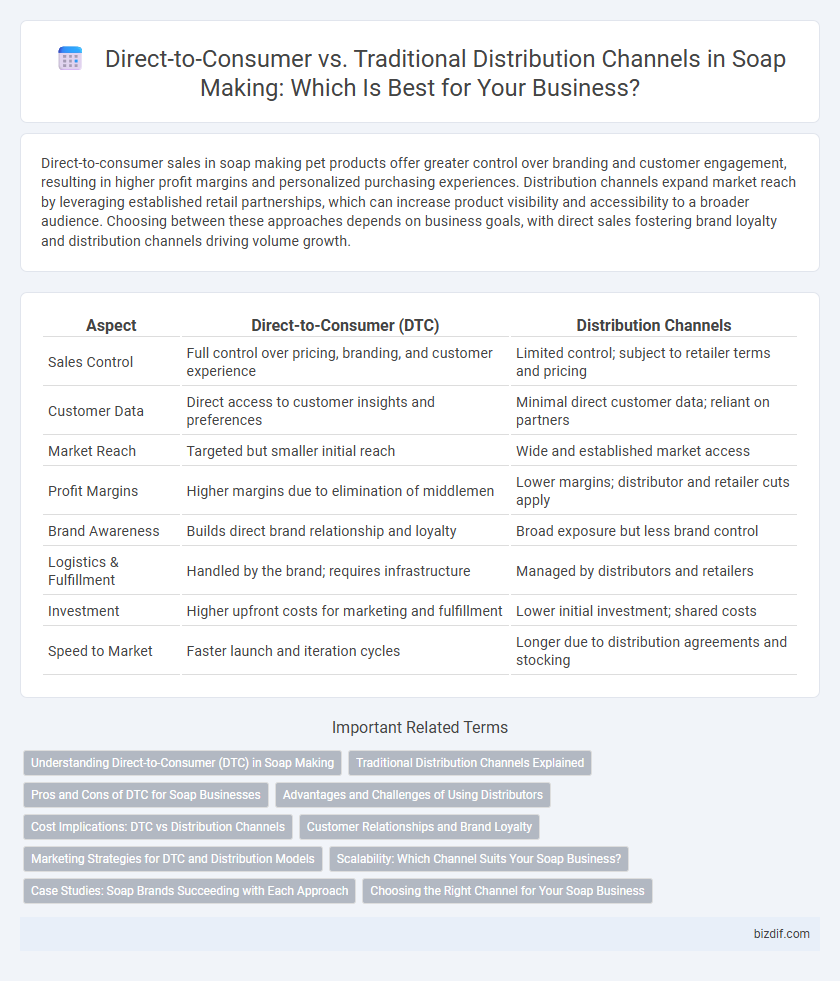Direct-to-consumer sales in soap making pet products offer greater control over branding and customer engagement, resulting in higher profit margins and personalized purchasing experiences. Distribution channels expand market reach by leveraging established retail partnerships, which can increase product visibility and accessibility to a broader audience. Choosing between these approaches depends on business goals, with direct sales fostering brand loyalty and distribution channels driving volume growth.
Table of Comparison
| Aspect | Direct-to-Consumer (DTC) | Distribution Channels |
|---|---|---|
| Sales Control | Full control over pricing, branding, and customer experience | Limited control; subject to retailer terms and pricing |
| Customer Data | Direct access to customer insights and preferences | Minimal direct customer data; reliant on partners |
| Market Reach | Targeted but smaller initial reach | Wide and established market access |
| Profit Margins | Higher margins due to elimination of middlemen | Lower margins; distributor and retailer cuts apply |
| Brand Awareness | Builds direct brand relationship and loyalty | Broad exposure but less brand control |
| Logistics & Fulfillment | Handled by the brand; requires infrastructure | Managed by distributors and retailers |
| Investment | Higher upfront costs for marketing and fulfillment | Lower initial investment; shared costs |
| Speed to Market | Faster launch and iteration cycles | Longer due to distribution agreements and stocking |
Understanding Direct-to-Consumer (DTC) in Soap Making
Direct-to-Consumer (DTC) in soap making allows brands to build direct relationships with customers, controlling branding, pricing, and customer feedback without intermediaries. This channel maximizes profit margins by eliminating distributor fees and offers opportunities for personalized marketing and product customization. Leveraging DTC strategies such as e-commerce platforms and social media enables soap makers to gather valuable consumer insights, fostering product innovation and stronger brand loyalty.
Traditional Distribution Channels Explained
Traditional distribution channels in soap making involve wholesalers, retailers, and distributors who purchase bulk soap products to sell directly to consumers. These intermediaries handle marketing, logistics, and customer service, enabling soap makers to reach a broader market without managing individual sales. This approach often increases product visibility in physical stores but may reduce profit margins due to the multiple layers of distribution.
Pros and Cons of DTC for Soap Businesses
Direct-to-Consumer (DTC) sales in soap making offer higher profit margins by eliminating intermediaries and allow brands to build strong customer relationships through personalized experiences and direct feedback loops. However, DTC requires significant investment in marketing, customer service, and logistics, which can be challenging for small soap businesses with limited resources. Unlike distribution channels that provide broad market access and established retail presence, DTC models demand continuous brand management and digital engagement to sustain growth.
Advantages and Challenges of Using Distributors
Using distributors in soap making expands market reach by leveraging established retail networks and reducing the burden of direct customer acquisition. This channel offers scalability and brand exposure but introduces challenges such as lower profit margins, limited control over branding, and dependency on distributor performance. Effective communication and strong partnerships are essential to mitigate risks and ensure consistent product representation.
Cost Implications: DTC vs Distribution Channels
Direct-to-consumer (DTC) soap brands often incur higher upfront marketing and fulfillment costs but retain full profit margins, enhancing long-term profitability. Distribution channels reduce individual order costs through bulk sales yet impose wholesale pricing, shrinking per-unit earnings for soap makers. Evaluating cost implications reveals that DTC prioritizes customer acquisition and brand control, while distribution channels focus on volume-driven revenue with lower profit margins.
Customer Relationships and Brand Loyalty
Direct-to-consumer soap makers cultivate deeper customer relationships through personalized experiences and direct feedback channels, enhancing brand loyalty by fostering trust and authenticity. Distribution channels often prioritize wider reach but can dilute the brand message and limit direct interaction, impacting customer retention negatively. Leveraging direct sales allows soap brands to create tailored marketing strategies that resonate more effectively with niche audiences, strengthening long-term loyalty.
Marketing Strategies for DTC and Distribution Models
Direct-to-Consumer (DTC) soap brands leverage personalized digital marketing strategies, such as social media advertising and influencer partnerships, to build strong customer relationships and gather valuable consumer insights. Distribution channel models rely on wholesale partnerships, retail placement, and third-party marketplaces to scale market reach and capitalize on established customer bases. Optimizing marketing efforts for DTC involves targeted content and brand storytelling, while distribution models benefit from strategic collaboration and expanded visibility across multiple points of sale.
Scalability: Which Channel Suits Your Soap Business?
Direct-to-consumer (DTC) channels offer higher profit margins and direct customer interaction, making them ideal for small-scale soap businesses aiming for personalized branding and controlled growth. Distribution channels, including retailers and wholesalers, enable rapid scalability by leveraging established networks and larger order volumes but often result in lower margins and less customer feedback. Selecting the right channel depends on your soap business's scalability goals, balancing the need for growth with profit margins and brand control.
Case Studies: Soap Brands Succeeding with Each Approach
Soap brands like Dr. Squatch thrive using direct-to-consumer (DTC) strategies by leveraging personalized marketing and customer loyalty programs to boost repeat sales and brand engagement. Conversely, brands such as Dove benefit from extensive distribution channels, placing products in retail giants like Walmart and Target to maximize reach and convenience for consumers. Case studies reveal DTC excels in niche markets with unique formulations, while broad distribution suits mass-market soaps aiming for high volume sales.
Choosing the Right Channel for Your Soap Business
Selecting the ideal sales channel for a soap business hinges on factors such as target market, brand positioning, and profit margins. Direct-to-consumer (DTC) platforms enable personalized customer experiences and higher profits by eliminating intermediaries, while distribution channels expand market reach through retailers and wholesalers. Analyzing consumer behavior, operational capacity, and marketing strategies ensures alignment with business goals and sustainable growth.
Direct-to-Consumer vs Distribution Channels Infographic

 bizdif.com
bizdif.com